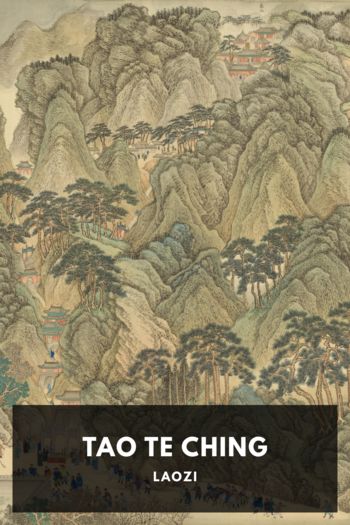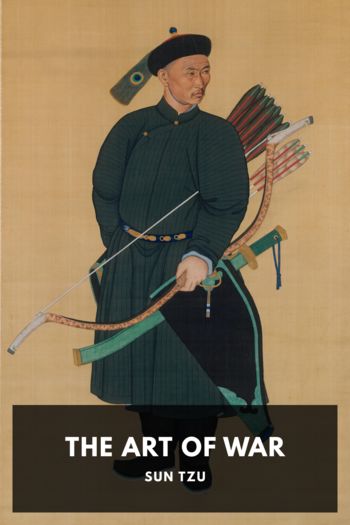Tao Te Ching by Laozi (reading comprehension books txt) 📕

- Author: Laozi
Book online «Tao Te Ching by Laozi (reading comprehension books txt) 📕». Author Laozi
All the editions of the book are divided into two parts, the former called “Tao”, and the latter “Tê”, meaning the Qualities or Characteristics of the Tao, but this distinction of subjects is by no means uniformly adhered to.
I referred already to the division of the whole into eighty-one short chapters (37 + 44), which is by common tradition attributed to Ho-shang Kung, or “The old man of the ho-side.” Another very early commentator, called Yen Tsun or Yen Chün-ping, made a division into seventy-two chapters (40 + 32), under the influence, no doubt, of some mystical considerations. His predecessor, perhaps, had no better reason for his eighty-one; but the names of his chapters were, for the most part, happily chosen, and have been preserved. Wu Chʽêng arranged the two parts in sixty-seven chapters (31 + 36). It is a mistake, however, to suppose, as even Mr. Wylie with all his general accuracy did,11 that Wu “curtails the ordinary text to some extent.” He does not curtail, but only rearranges according to his fashion, uniting some of Ho-shang Kung’s chapters in one, and sometimes altering the order their clauses.
Ssŭ-ma Chʽien tells us that, as the treatise came from Laozi, it contained more than 5,000 characters; that is, as one critic says, “more than 5,000 and fewer than 6,000.” Ho-shang Kung’s text has 5,350, and one copy 5,590; Wang Pi’s, 5,683, and one copy 5,610. Two other early texts have been counted, giving 5,720 and 5,635 characters respectively. The brevity arises from the terse conciseness of the style, owing mainly to the absence of the embellishment of particles, which forms so striking a peculiarity in the composition of Mencius and Chuang-tzŭ.
In passing on to speak, secondly and more briefly, of the far more voluminous writings of Chuang-tzŭ, I may say that I do not know of any other book so ancient a date as the Tao Te Ching, of which the authenticity of the origin and genuineness of the text can claim to be so well substantiated.12
What Is the Meaning of the Name Tao? And the Chief Points of the Belief in TaoismThe first translation of the Tao Te Ching into a western language was executed in Latin by some of the Roman Catholic missionaries, and a copy of it was brought to England by a Mr. Matthew Raper, F.R.S., and presented by him to the Society at a meeting on the 10th January, 1788—being the gift to him of P. Jos. de Grammont, Missionarius Apostolicus, ex-Jesuita. In this version Tao is taken in the sense of “ratio,” or the “supreme reason of the divine being, the creator and governor.”
M. Abel-Rémusat, the first professor of Chinese in Paris, does not seem to have been aware of the existence of the above version in London, but his attention was attracted to Lao’s treatise about 1820, and, in 1823, he wrote of the character Tao, “Ce mot me semble ne pas pouvoir être bien traduit, si ce n’est par le mot λόγος dans le triple sense de souverain Être, de raison, et de parole.”
Rémusat’s successor in the chair of Chinese, the late Stanislas Julien, published in 1842 a translation of the whole treatise. Having concluded from an examination of it, and the earliest Taoist writers, such as Chuang-tzŭ, Ho-kuan Tzŭ, and Ho-shang Kung, that the Tao was devoid of action, of thought, of judgement, and of intelligence, he concluded that it was impossible to understand by it “the primordial reason, or the sublime intelligence which created, and which governs the world.” and to this he subjoined the following note:—“Quelque étrange que puisse paraître cette idée de Laozi, elle n’est pas sans exemple dans l’histoire de la philosophie. Le mot nature n’a-t-il pas été employee par certains philosophes, que la religion et la raison condamnent, pour désigner une cause première, également dépourvue de pensée et d’intelligence?” Julien himself did not doubt that Lao’s idea of the character was that it primarily and properly meant “a way,” and hence he translated the title Tao Te Ching by Le Livre de la Voie et de la Vertu, transferring at the same time the name Tao to the text of his version.
The first English writer who endeavoured to give a distinct account of Taoism was the late Archdeacon Hardwick, while he held the office of Christian Advocate in the University of Cambridge. In his Christ and Other Masters (vol. ii p. 67), when treating of the religions of China, he says, “I feel disposed to argue that the centre of the system founded by Laozi had been awarded to some energy or power resembling the ‘nature’ of modern speculators. The indefinite expression Tao was adopted to denominate an abstract cause, or the initial principle of life and order, to which worshippers were able to assign the attributes of immateriality, eternity, immensity, invisibility.”
It was, probably, Julien’s reference in his note to the use of the term nature, which suggested to Hardwick his analogy between Laozi’s Tao, and “the nature of modern speculation.” Canon Farrar has said, “We have long personified under the name of nature the sum total of God’s laws as observed in the physical world; and





Comments (0)